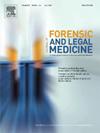死后受试者血清无细胞DNA释放的机制及估计死后时间间隔的新标记。
IF 1.2
4区 医学
Q3 MEDICINE, LEGAL
引用次数: 0
摘要
游离DNA (cfDNA)是从死亡细胞释放到血清中的DNA。本研究的目的是通过分析细胞角蛋白18 (M30和M65)、亲环蛋白A (CyPA)和髓过氧化物酶(MPO)水平来阐明死后受试者游离DNA (cfDNA)释放的机制,并评估这些水平是否可用作估计死后时间间隔的标记。血清(n = 54)采集自死后尸检的日本受试者。提取cfDNA,采用酶联免疫吸附法检测血清中M30、M65、CyPA、MPO的含量。死后受试者的血清M30、M65和MPO水平明显高于活着的受试者。尽管差异较小,但死后受试者的CyPA也明显高于活着的受试者。此外,死后受试者血清M30和MPO水平与cfDNA浓度显著相关。M30水平随死后时间的延长略有升高,2.5 d时MPO水平显著高于2.5 d时本文章由计算机程序翻译,如有差异,请以英文原文为准。
The mechanism of serum cell-free DNA release in postmortem subjects and novel markers to estimate the postmortem intervals
Cell-free DNA (cfDNA) is DNA released from dying cells into the serum. The aim of the present study is to elucidate the mechanism of cell-free DNA (cfDNA) release in postmortem subjects by assaying Cytokeratin 18 (M30 and M65), cyclophilin A (CyPA), and myeloperoxidase (MPO) levels and to evaluate whether these levels are useful as markers for estimating postmortem intervals. Serum (n = 54) was sampled from postmortem autopsied Japanese subjects. cfDNA was extracted and M30, M65, CyPA, and MPO in serum were assayed by enzyme-linked immunosorbent assay. Significantly higher serum levels of M30, M65, and MPO were observed in postmortem subjects than in living subjects. Although the difference was smaller, CyPA was also significantly higher in postmortem subjects than in living subjects. In addition, serum M30 and MPO levels were significantly correlated with cfDNA concentrations in postmortem subjects. Furthermore, M30 levels slightly increased according to the postmortem interval, and MPO levels at 2.5 days were significantly higher than those at <2 days. The result of regression analysis revealed a significant difference between M30/MPO levels and postmortem intervals. These findings suggested that elevated levels of cfDNA in postmortem subjects are released by apoptosis and neutrophils via NETosis and that M30 and MPO levels can be used as markers to estimate postmortem intervals.
求助全文
通过发布文献求助,成功后即可免费获取论文全文。
去求助
来源期刊

Journal of forensic and legal medicine
MEDICINE, LEGAL-
CiteScore
2.70
自引率
6.70%
发文量
106
审稿时长
57 days
期刊介绍:
The Journal of Forensic and Legal Medicine publishes topical articles on aspects of forensic and legal medicine. Specifically the Journal supports research that explores the medical principles of care and forensic assessment of individuals, whether adult or child, in contact with the judicial system. It is a fully peer-review hybrid journal with a broad international perspective.
The Journal accepts submissions of original research, review articles, and pertinent case studies, editorials, and commentaries in relevant areas of Forensic and Legal Medicine, Context of Practice, and Education and Training.
The Journal adheres to strict publication ethical guidelines, and actively supports a culture of inclusive and representative publication.
 求助内容:
求助内容: 应助结果提醒方式:
应助结果提醒方式:


